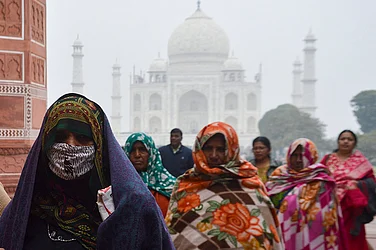On February 4, while addressing the Bharatiya Janata Party’s (BJP) Vijay Sankalp Rally in Deoghar, Jharkhand, Union Home Minister Amit Shah accused the state chief minister Hemant Soren of “turning a blind eye to the fact that the Adivasi population in the state has depleted from 35 per cent to 24 per cent”.
Official numbers corroborate Union minister’s statement. Between 1931 and 2011, there has been a difference of 11.9 per cent in the Adivasi population in the state. While it was 38 per cent (1931 Census), in the span of 80 years, it came down to 26.2 per cent (2011 Census). The Adivasi population stood at 27.7 per cent (1991 Census), 26.3 per cent (2001 Census) and 26.2 per cent (2011 Census).
India recently surpassed China to become the most populous country. In this context, it is important to understand the reasons behind the ‘decrease’ in Adivasi population in Jharkhand.
Changing Demography
The Jharkhand’s population stands at 3.29 crore — Scheduled Tribes (STs) constitute 86.5 lakh of the total population.
The BJP has repeatedly raised the issue of “changing demography” of Santhal Pargana — one of the divisions of Jharkhand which comprises six districts of Godda, Deoghar, Dumka, Jamtara, Sahibganj, and Pakur. It makes the eastern and north-eastern stretch of Jharkhand, sharing borders with West Bengal.
The party claims illegal immigration from Bangladesh has led to the decline in the population of Adivasis and Other Backward Classes (OBCs) in the state. The BJP has even promised a “Mini NRC” (National Register of Citizens) in Santhal Pargana. Incidentally, the region is a stronghold of the ruling alliance of Congress and Jharkhand Mukti Morcha (JMM).
Jharkhand BJP Spokesperson Pratul Shahdev claims it’s a fact that Bangladeshi infiltrators have settled in Santhal Pargana, and the present state government has allowed them to settle here for votes and has provided them with all the facilities.
“Due to these infiltrators, the Adivasi population has been affected. The percentage of Adivasis is decreasing because people who have been living here for decades are forced to migrate to other cities in search of work. On the other hand, Bangladeshi infiltrators are coming and settling here,” he says.
Unemployment And Poverty
Karma Oraon, a retired professor from the Ranchi University, blames factors like migration, poverty, unemployment, malnutrition, and religious conversion for the dwindling Adivasi population.
“The Adivasi population is not declining; they are simply moving out. Due to unemployment, locals, especially from Gumla, Simdega, and Latehar districts, have been moving to bigger towns and cities for work,” he says.
During the first lockdown, between April and June 2020, the state department received calls from 11 lakh migrant labourers, including Adivasis, who were stranded in different cities. Most of them had lost their jobs and were looking for employment opportunities in their home state.
Jharkhand’s unemployment rate rose to 59.2 per cent in May 2020, according to a Centre for Monitoring Indian Economy (CMIE) survey. In 2021-22, the unemployment rate in the state continued to be higher than the pre-Covid levels, revealed the economic survey tabled in the state assembly.
According to NITI Aayog’s first Multidimensional Poverty Index (MPI) report released in 2021, 42.2 per cent people in Jharkhand are poor. While Bihar topped the list, Jharkhand came close second.
Safe and Responsible Migration Initiative (SRMI) findings reveal that Adivasis constitute a significant part of the migrant outflow.
Poverty and unemployment have played a huge role in migration of a large number of rural Adiv¬asi population from Jharkhand to other parts of the country.
Due to abject poverty, issues like malnutrition and anaemia are also prevalent. As per the National Family Health Survey-5, in Jharkhand, 45 per cent children are stunted —too short for their age— and 22 per cent children are wasted — too thin for their height. The report also states that 67 per cent of children aged 6-59 months in the state are anaemic.
Displacement due to mining is another factor that has led to migration from the mineral-rich state. Human rights activist and author Gladson Dungdung notes in his book Vikas ki Kabragah (The Graveyard of Development) that, in Jharkhand, between 1951 and 1995, more than 15 lakh people were displaced — 80-90 per cent were Adivasis and those belonging to indigenous communities.
Migration For Employment
The Economic Survey of India data reveals that Jharkhand lost close to 5 million of its working-age population between 2001 and 2011 due to migration.
Nearly 8.5 lakh migrant workers belonging to the state travelled back to Jharkhand during the Covid crisis. In 2021, to enable systemic registration of migrant workers for monitoring and analysis in the source as well as destination districts, the state government launched the Safe and Responsible Migration Initiative (SRMI). One of the early findings revealed that people from Adivasi communities, about 26.2 per cent of Jharkhand’s population, constitute a significant part of the migrant outflow.
Jyoti Prakash, Assistant Professor, Ranchi University, who is doing his research on Adivasi population from Tribal Research Institute, feels seasonal migration is the prime reason why it seems the number of Adivasis has gone down.
“They (migrant population) are often not counted during census. We call this under counting,” he says.
However, according to Prakash, it is important to look at the Adivasi population keeping in mind the overall increase in the population.
“Generally, people form a perception of decreasing population by just observing the difference in the percentage. Overall, in a span of 10 years, the population of Jharkhand has increased from 2.69 crore to 3.29 crore. Once we look at the percentage in accordance with an increase in population, we will realise that there may have been an increase in Adivasi population. What is worrying is that this percentage of increase is not very high,” he says.
Religious Conversions
In 2022, taking suo-moto cognisance of a news report, the National Commission for Protection of Child Rights (NCPCR) said, “It has been brought to the notice of the Commission that 12 children of Khunti district in Jharkhand have been illegally converted to Christianity by Torpa Arsee Church.”
Through the said news report, it was also discovered that such illegal conversions had been taking place in the village for some time. The NCPCR said it believes such conversions are a violation of the Juvenile Justice (Care and Protection of Children) Act, 2015 and of the Religious Conversion Act passed by the Jharkhand Assembly in 2017.
In 2021, BJP MP from Jharkhand, Sanjay Seth, raised the issue of religious conversions in the state in Lok Sabha.
“The religious conversion of tribals is a major issue in Jharkhand. In the small district of Simdega alone, there are 2,400 churches with 300 in Simdega town alone. The missionaries are involved in luring innocent tribals and converting them…during the lockdown, missionaries were active in distributing rations at Giridih, Simdega, Ranchi, Khuti and other districts and put the condition of conversion for rations,” he said.
Oraon, who has been advocating for a separate religious identity for the Adivasis for a long time, believes, along with several other factors, religious conversions have led to the decline in the Adivasi population in Jharkhand. For long, Adivasis in Jharkhand have demanded their own religion and there has been a strong demand for recognition of Sarnaism in the state. Sarnaism is a religious tradition that revolves around the worship of trees and other natural elements.
______________________________________________________________________________________________
This appeared in print as "Cause And Effect"



























